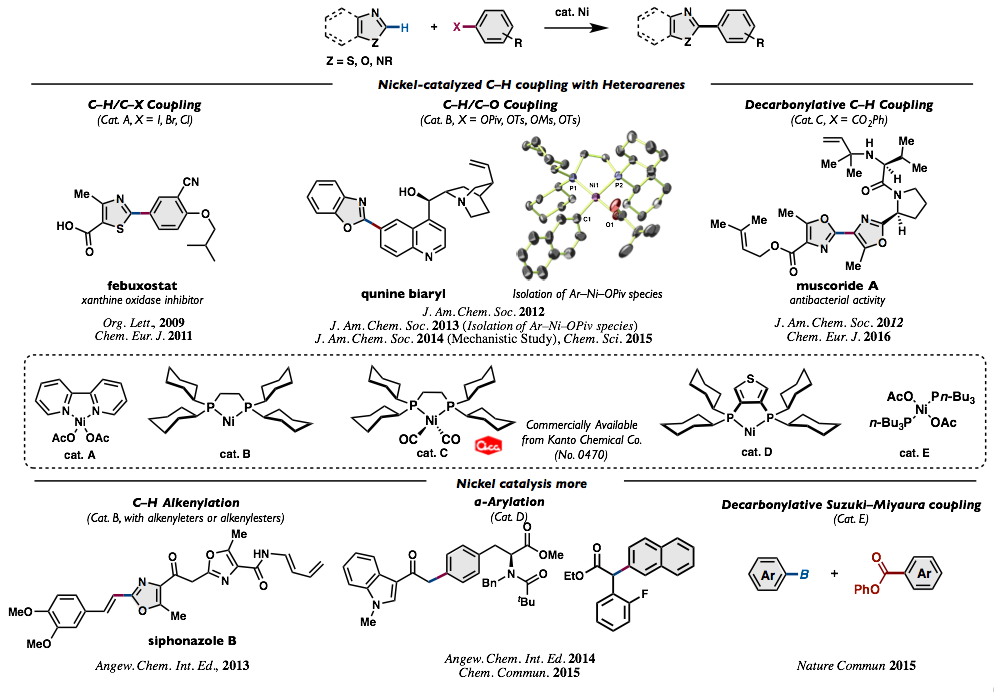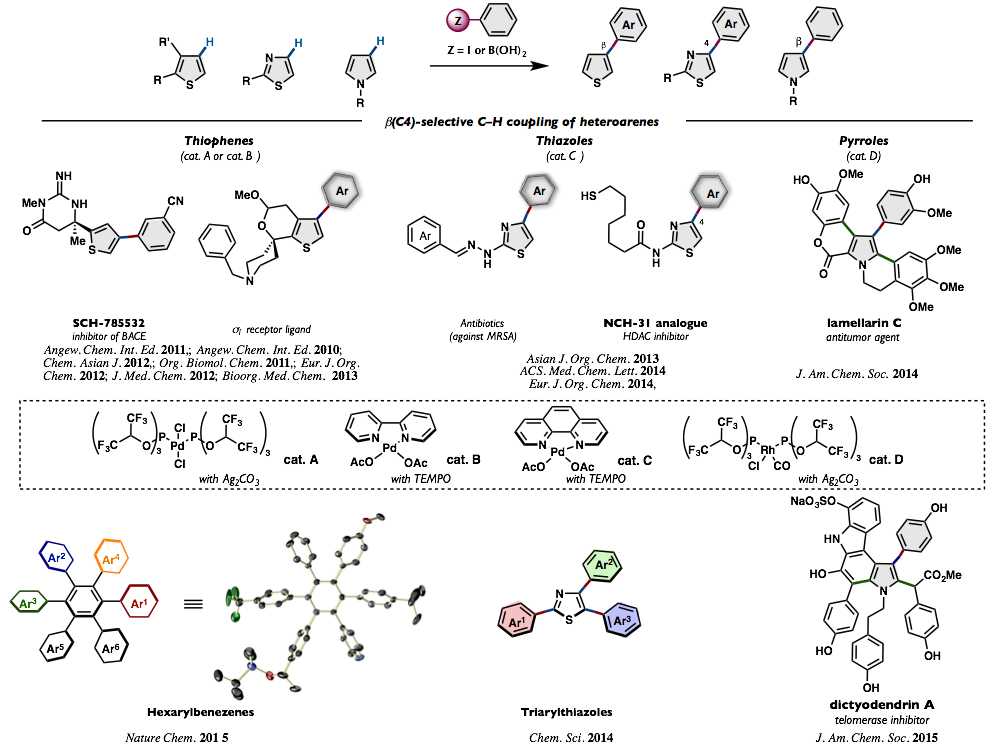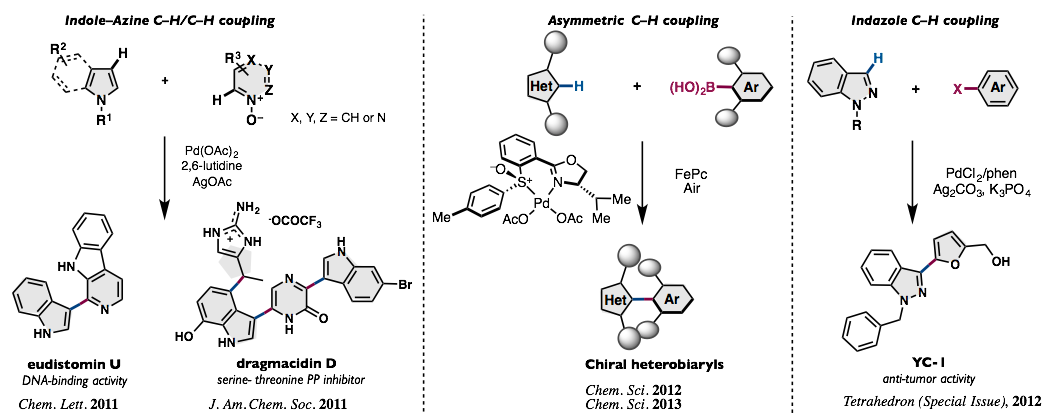- Home
- Building molecules
Building molecules
There has been a wealth of knowledge surrounding the development of methods for molecular construction. In the case of organic compounds, important methods to build molecules involve the creation of a link between two carbon atoms, otherwise known as carbon–carbon bond formation. For example, cross-coupling methodology, which was awarded the 2010 Nobel Prize in Chemistry, is a fantastic reaction that allows scientists to link a variety of organic molecules together. We plan to expand this coupling method further, and aim to develop catalysts and reactions that can forge new molecular entities at will.
Previous Results
Toward an Ideal Synthesis of Bioactive Molecules Through Direct Arene Assembling
Biaryls and heterobiaryls are ubiquitous motifs in pharmaceuticals, natural products, and organic materials alike, and therefore, the construction of these scaffolds has been a topic of great importance in chemistry. Recently, C–H coupling of aromatic compounds using transition metal catalysts has garnered much attention from the synthetic chemistry community as a next-generation coupling method for constructing (hetero)biaryl motifs. Although the development of new reactions and catalysts continues to evolve at a rapid pace, successful applications of this method to the synthesis of natural products and pharmaceuticals are still rare. Thus, our research program has focused on synthesis-oriented methodology development in catalytic C–H coupling (direct arene–assembling reactions). As a result, more than ten new C–H coupling reactions of heteroarenes such as 1,3-azoles, indoles, pyrroles, azines and thiophenes have been developed and utilized for the rapid synthesis of bioactive molecules such as natural products and pharmaceutical candidates. Furthermore, the method of late-stage C–H coupling can be highly relevant for medicinal chemistry.
Ni-Catalyzed C–H Coupling of Azoles
Ni-catalyzed cross-coupling reactions have recently attracted much attention from the synthetic chemistry community as a way to construct C–C or C–heteroatom bonds, because Ni catalysts are less expensive and toxic than their Pd counterparts. The applicant has developed a number of difficult C–H coupling reactions that can be uniquely catalyzed by nickel. Initially, we have developed the C–H coupling of azoles with haloarenes (C–H/C–X coupling) by using a Ni(OAc)2/bipy catalyst and a metal t-butoxide base. This newly developed C–H coupling enabled the rapid synthesis of bioactive molecules. The applicant has discovered that Ni(cod)2/dcype (dcype: 1,2-bis-dicyclohexylphosphinoethane) can catalyze the C–H/C–O coupling of azoles with phenol derivatives as well. Furthermore, during the investigation of C–H/C–O coupling, the applicant has also discovered that Ni/dcype catalyzes the decarbonylative C–H arylation of azoles with phenyl esters. These Ni-catalyzed reactions can be applied to the rapid synthesis of hybrid natural products as well as muscoride A, which is a natural product with antibacterial activity. The Ni/dcype catalyst system mentioned above allows the incorporation of unconventional alkenylation agents, enol derivatives and alkenyl esters. The rapid and convergent synthesis of siphonazole B was also accomplished.
C4-selective C–H Arylation of Thiazoles, Thiazoles, and Pyrroles
Two novel catalytic systems (palladium catalysis) for the b-selective C–H bond arylation of thiophenes/thiazoles with iodoarenes and arylboronic acids have been established. This previously inaccessible, beta-selective functionalization of thiophenes offers significant synthetic utility in heterocyclic chemistry. This method can be applied to the rapid and versatile synthesis of SCH-785532 (an inhibitor of BACE), as well as to the total synthesis of dragmacidin D . The applicant also expanded this method for medicinal chemistry, for example, for the synthesis of a potent sigma1 ligand by utilizing a late-stage C–H diversification (alpha- or beta-selective C–H coupling of thiophenes). A programmed synthesis of triarylthiazoles has also been accomplished, which supplied over 150 arylthiazoles for biological testing. Furthermore, very recently, the applicant has found that a C–H coupling of pyrroles and iodoarenes occurs by using a Rh catalyst. Interestingly, the developed catalyst system manifests a unique regioselectivity that elicits reaction at the b-position of the pyrrole ring. A total synthesis of lamellarin I was established using this b-selective direct arylation along with a double intramolecular C–H/C–H coupling as key steps.
Indole/Azine C–H/C–H Coupling
Indole/pyrrole–azine moieties are well-known structures that form the core of significantly bioactive molecules. In the past few years, pioneering work involving oxidative C–H/C–H biaryl coupling reactions has been reported. However, a direct coupling that enables the access of indole/pyrrole–azine structures had not been achieved. This applicant has developed a novel Pd-catalyzed C–H/C–H coupling reaction of indoles and azine N-oxides. Furthermore, the synthesis of biologically active compounds such as eudistomin U and dragmacidin D have been accomplished by utilizing this indole–azine C–H/C–H coupling reaction.
Hindered Heterobiaryls by C–H Coupling: New Generation Catalysts
Sterically hindered (hetero)biaryls with multiple ortho-substituents have numerous applications. There are fewer examples of hindered biaryl formation that proceeds through a C–H coupling manifold due to its relatively low catalytic activity. The applicant has developed new Pd-catalyzed C–H/C–B couplings of sterically hindered heteroarenes and arylboronic acids. An enantioselective C–H biaryl coupling with this catalyst will also be demonstrated.
Thus, we have developed unique C–H couplings of heteroarenes that are difficult to achieve (unless using classical cross-coupling reactions of pre-functionalized substrates), has accomplished the rapid synthesis of bioactive compounds, and has demonstrated the utility of C–H coupling in a medicinal chemistry-oriented divergent synthesis. Bringing together heteroarenes in an ideal fashion, using C–H coupling to generate useful assemblies, is the applicant’s longstanding goal.


 日本語
日本語 中文
中文

